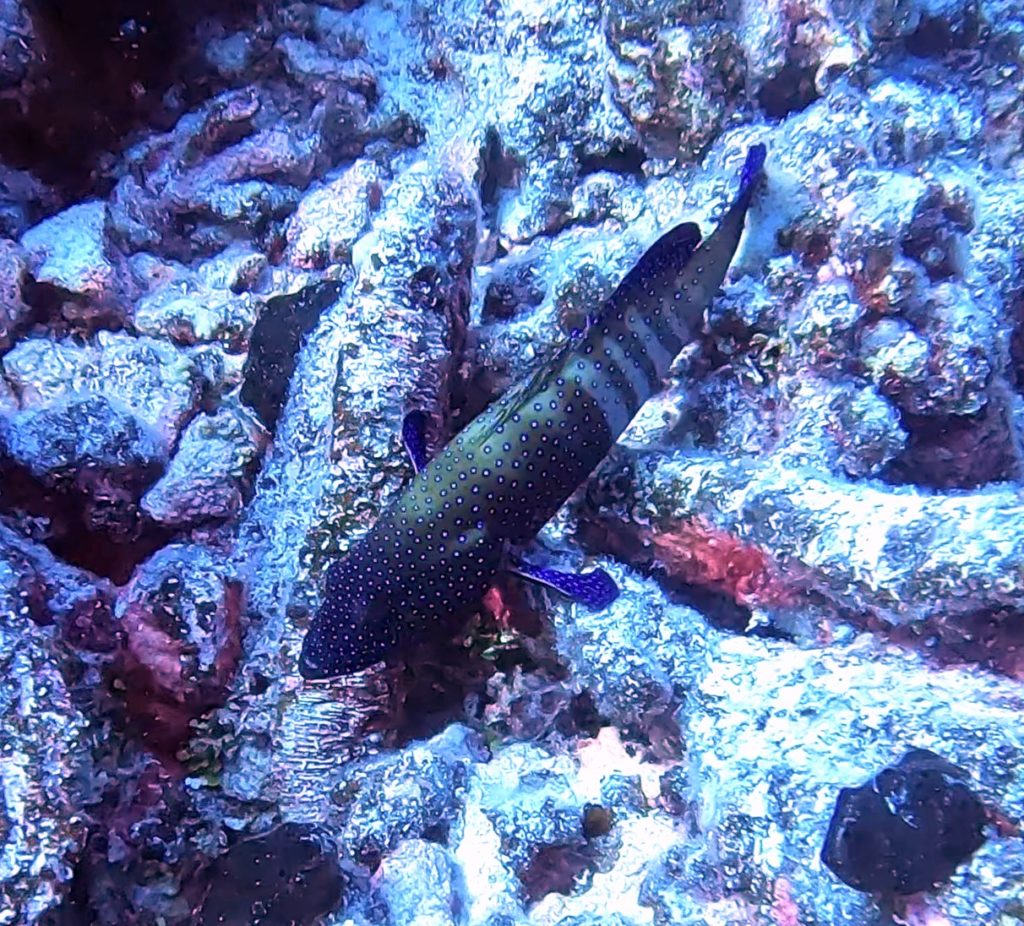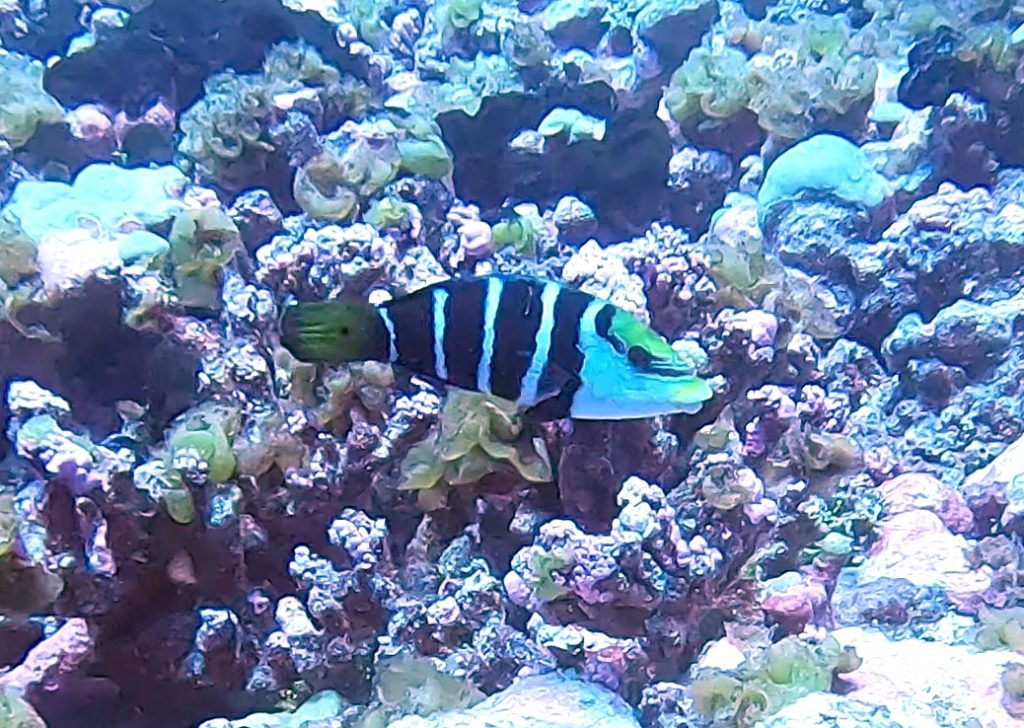Toau is pretty above the water, but all the best stuff is below. We snorkeled almost every day, usually dragging the dinghy behind us as we drifted in through the pass or south along the shelf outside of it.



Because this is the Tuamotus, there were plenty of sharks, and lots of parrotfish.


Plenty of fish in general, actually. The biggest schools seemed to hang out right at the inside of the pass, right before the drop-off into the anchorage.


Some especially cool looking examples: a striped surgeonfish, and a pacific bird wrasse.


We’d occasionally get passed by a giant school of these convict surgeonfish, which flowed over the coral and would descend all at once to munch. We’d seen this before in the Caribbean, where the blue tangs school like this to avoid the wrath of territorial damselfish.

There were lots of these crown-of-thorn starfish, and even more of these top snails.


We discovered several such snails, overturned and waiting to be lunch, outside the lair of these two octopuses. It was a real treat to see two at once, they’re usually solitary. Neither was very interested in showing off for us, and they slithered back into their holes when we got too close. But this one did change his colors, white to red, which was fun to watch. Honestly they’re probably right to be skittish around humans, what with the local restaurant serving seven-course seafood lunches.




On the days we didn’t snorkel, we went scuba diving! Of all the islands we’ve visited, this is the place where we’ve most wished we had a compressor of our own. But we only had two tanks each, so we only did two dives. For the first, we waited for a calm day and took Dinkus up to a site called Yellow Dog. The compendium claims that there’s a buoy, but we’d been told that it had washed away, so we just did the dive as a drift with Dinkus on a leash. There was a nice light southbound current, enough to keep us moving but not enough to really restrict our movement much. Look, we took turns!




Not far into the dive, we were passed by a big school of barracudas. A little later, we saw a small group of sharks on patrol. It always pays to keep an eye out towards the blue…


Back on the reef, we saw a nice wide variety of sea cucumbers.



Here’s a cowrie and a giant clam. Fun fact we learned after the dive: there’s a type of gastropod here that looks a bit like that cowrie, that hunts and eats fish with its paralyzing, toxic sting. Don’t touch the big snail-looking things!


Butterfly fish are common here. Here’s a longnose butterfly, trimmed for travel and then with its fins flared in what we assume is surprise at noticing humans down here.


Slightly less common butterflies include this atoll butterflyfish, with its neat pixely stripes, and its horizontally striped cousin the reticulated butterflyfish.


Slightly more distant cousins, here are some masked and pennant bannerfish.


There are usually lots of wrasses. Some of the cooler ones were this yellow-breasted wrasse, a yellow-pink one we can’t identify, and the tiny bluestreak cleaning wrasse that’s working over that moray eel.



From the spotty lurker department, here’s a flagtail grouper, a peacock grouper, and a lighter one we’re not sure about.



The prevailing species of damselfish here seems to be this yellow-tailed dascyllus.


From the department of fish with flair, here’s a goldsaddle goatfish and a parrotfish, both with great eye makeup, and a trumpetfish who spent a long time working on those tail dots.


Angelfish are also abundant here. Here’s an emperor, a two-spined angelfish (with the orange stripes), and a flame angel right next to a lemonpeel angel.



We don’t see boxfish as often, but there were a lot on this dive. First, a spotted boxfish, and then both female (brown) and male (blue) Whitley’s Boxfish.




Always a favorite, perching and watching for their moment to strike, an arc-eye and a halfspotted hawkfish.


As we passed along the reef wall, we ran into a huge school of trevallies. They basically just ignored us, and the whole school passed basically within arms reach of Andrew.



We had been told that the spot where we started was the best dive on the island. But we thought that the coral and fish were actually looking healthier around when we got out of the water, maybe halfway between the markers for Yellow Dog and Snapper Hole. In case anyone is reading this for advice. 🙂


For our second dive, we planned to go through the pass at the end of the incoming tide. And then we got out to the dive site, and realized we’d forgotten our masks, so we had to go back to the boat. By which point the tide was going out, and we weren’t able to enter; instead, we just did a drift along the reef, still trailing Dinkus on a long line. This turned out to also be a good plan, and we saw just a ton of fish. Left, a small cave full of bigscale soldier fish; right, a big school of bluestripe snapper with a trumpetfish doing its best to fit in.


There’s a similar imposter trumpet in the next photo, trying to shadow-hunt “behind” a fish half its size. But the star of these pictures is the pyramid butterflyfish.


A paletailed bristletooth and a longnose tang.


Left, a barred thicklip; right, we think, a mimic surgeonfish still completing its color transition from yellow to brown.


And, of course, there were sharks. We got some reasonably close passes from a couple of blacktips.



We also got a close pass from this red snapper, who showed us his most menacing teefers before giving us the side-eye. Absolutely adorable.


Here’s a slingjaw wrasse and a sabre squirrelfish.


Here’s an Andrewfish, staring raptly at this little school of juvenile threespot dascyllus. dascylluses. Dascylli? Whatever.


And finally, a scythe triggerfish (common in the Marquesas but we don’t see many here), and some colorful midget cromies.
































































